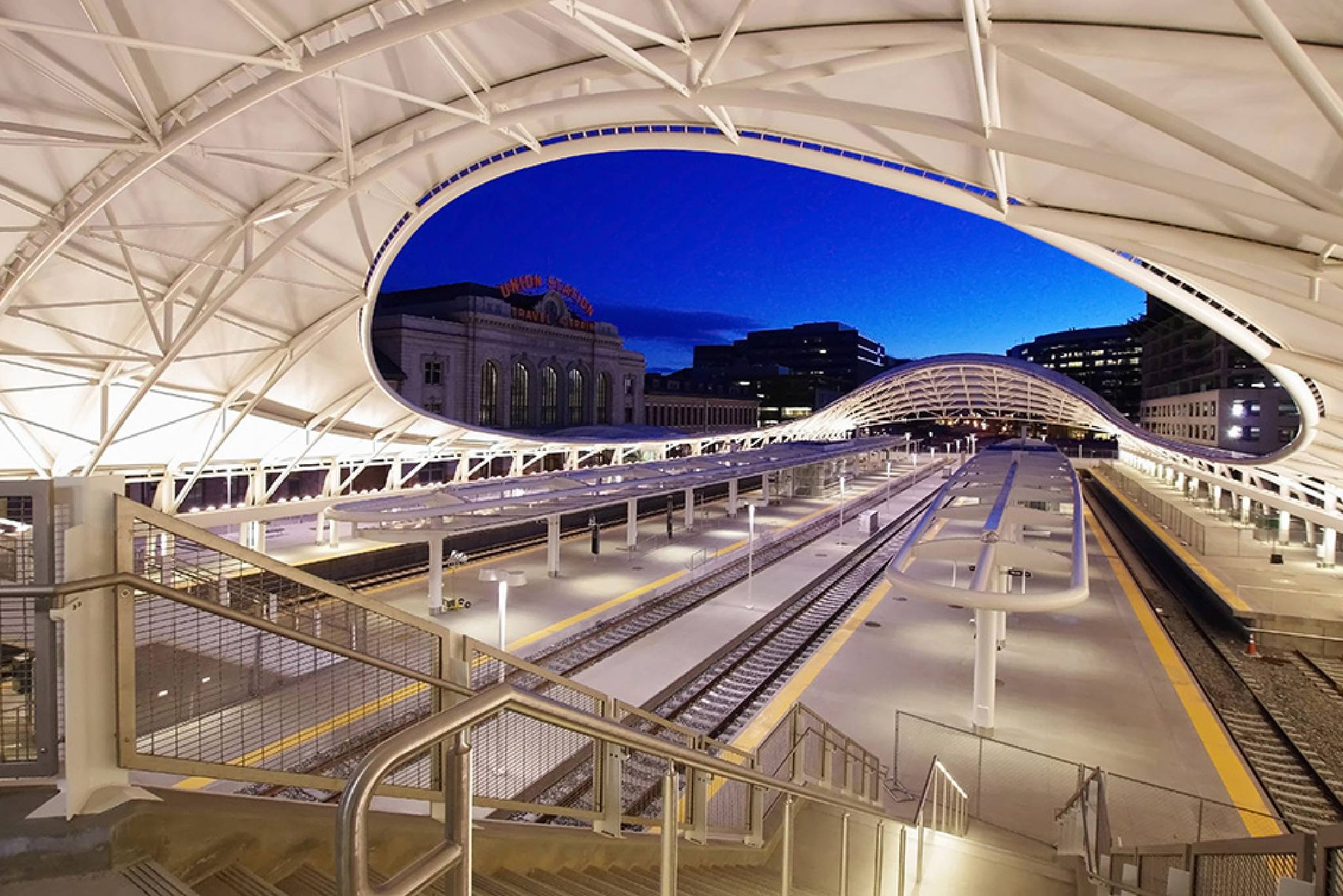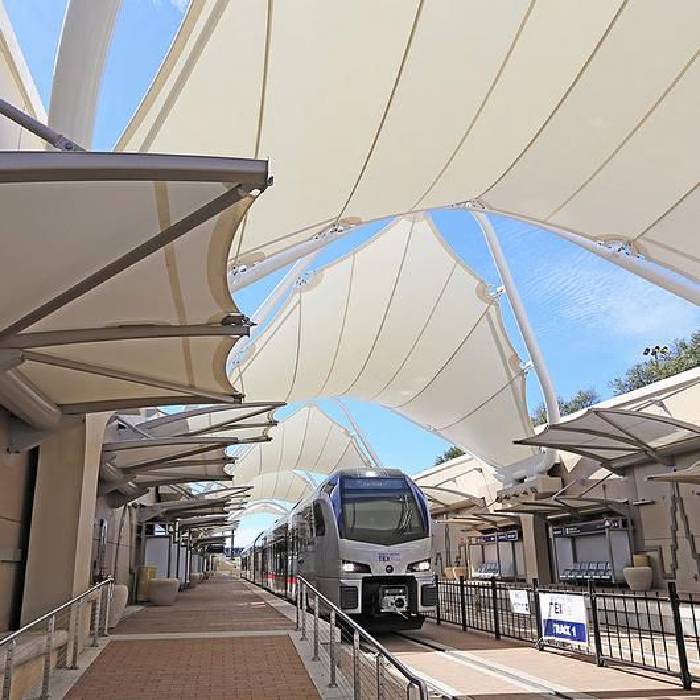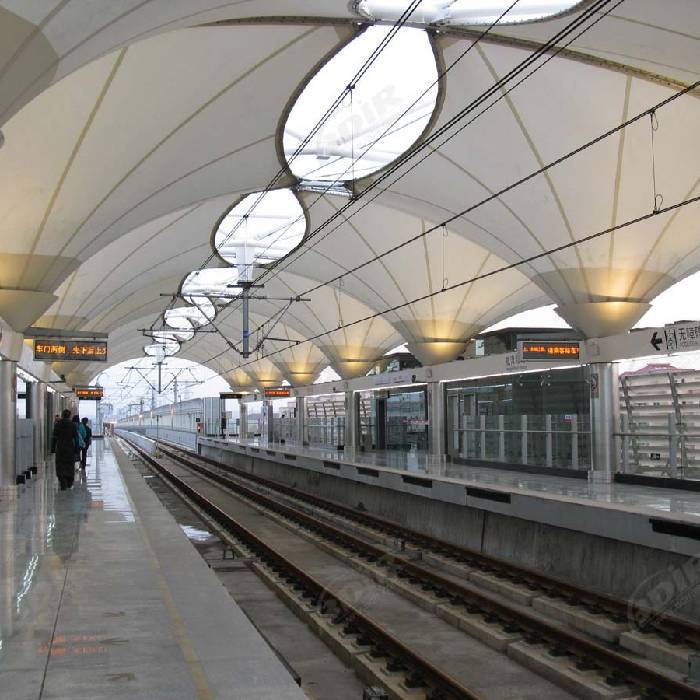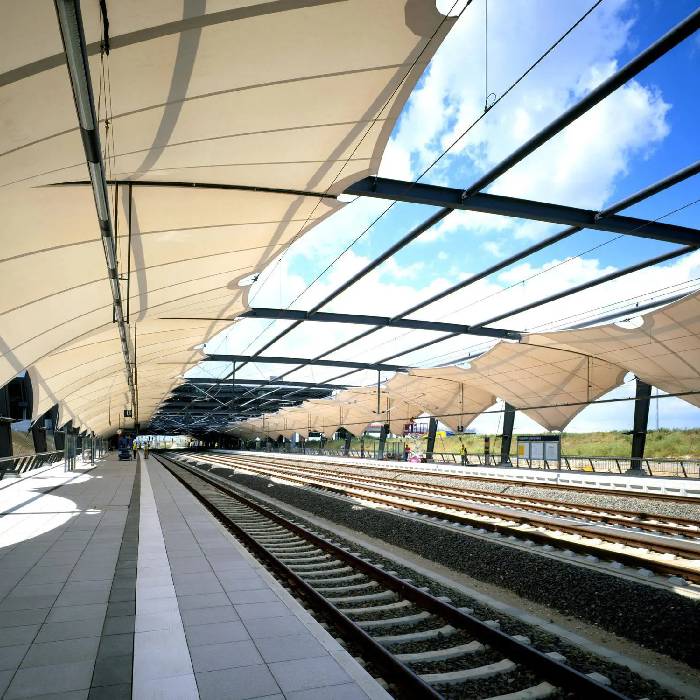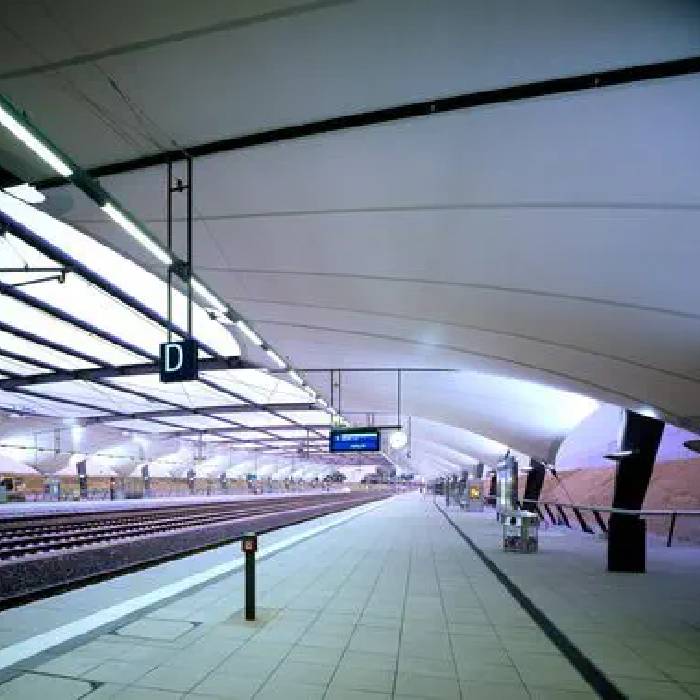"Krishna Carports - Your Trusted Partner for Premium Tensile Fabric Structure For Metro Rail Stations"
Overview
Krishna Carports offers high-quality tensile structures. We create, produce, and install a range of attractive, functional, and lasting tensile structures. Our commercial, industrial, and residential tensile structures include carports, canopies, awnings, and shades. Our constructions are weatherproof, energy-efficient, and long-lasting, thanks to cutting-edge technology and high-quality materials.
Krishna Carports offers custom tensile structures since every client's demands are unique. Our skilled designers and engineers intimately understand customers' demands and preferences and create personalised buildings that exceed their expectations. Design, engineering, installation, and maintenance are our specialities. Our expert professionals use the latest technology and techniques to carefully install every product.
We work hard to give our customers the greatest experience possible since we think quality and customer happiness are extremely important. Our team of professionals is always on hand to address any inquiries and offer direction throughout the procedure.
Quality Control System
High-quality goods and services are offered by Krishna Carports. To assure quality, we have a complete system in place for quality assurance that includes every aspect of our business.
100% Satisfaction Guarantee
We sell carports that are strong and look good. We want people to be happy with the quality of our goods. Our carports come with a promise that you will be happy with them.
Highly Professional Staff
Krishna Carports' skilled staff strives to provide the best service. Every project is completed by our talented designers, engineers, installers, and customer care representatives.
Accurate Testing Processes
Krishna Carports takes pleasure in providing the greatest carports. We developed accurate testing methodologies to ensure the strength, durability, and longevity of our products.
Tensile Fabric Structure For Metro Rail Stations
Tensile fabric structures provide a versatile and practical solution for metro rail stations, enhancing their functionality and aesthetic appeal. These structures can be designed to cover platforms, entrances, and other areas within the station, offering weather protection and creating comfortable waiting areas for commuters. The lightweight and flexible nature of the fabric allows for creative and innovative designs that can seamlessly integrate with the existing architecture of the metro station. Tensile fabric structures can be customized in terms of shape, size, and color, enabling architects and designers to create visually striking and unique structures that enhance the overall aesthetics of the station.
Additionally, the translucent properties of the fabric allow for diffused natural light, creating a pleasant and inviting atmosphere for passengers. Tensile fabric structures also provide acoustic benefits, helping to control sound reflections and improving the overall acoustic environment within the station. With their resilience, simplicity of upkeep, and capacity to blend harmoniously with the surrounding environment, tensile fabric structures offer a practical and attractive solution for metro rail stations, enhancing the commuting experience for passengers while adding a touch of architectural elegance to the urban landscape.
Design Expertise and Customization
Design expertise and customization are crucial in implementing tensile fabric structures for metro rail stations. Design professionals with expertise in tensile fabric architecture collaborate closely with architects, engineers, and stakeholders to understand the metro station's specific requirements and design goals. They consider the station layout, passenger flow, aesthetic objectives, and branding opportunities to create a customized solution. Tensile fabric structures offer various design possibilities, including different shapes, sizes, and configurations. Design experts ensure that the fabric structure not only fulfills functional aspects such as weather protection and durability but also enhances the overall visual appeal of the metro station.
They can incorporate branding elements, signage, and lighting, creating a cohesive and visually striking station experience. With their expertise, design professionals ensure that the tensile fabric structure harmoniously integrates with the station's existing architecture, creating an aesthetically pleasing and functional space for commuters. The customization options and attention to detail offered by design experts result in a unique and visually captivating tensile fabric structure that enhances the identity and appeal of the metro rail station.
Quality Materials and Craftsmanship
Quality materials and craftsmanship are essential when implementing tensile fabric structures for metro rail stations. These structures rely on durable and high-performance materials specifically engineered for outdoor use. The selection of materials is crucial as they need to possess excellent tensile strength, UV resistance, fire retardant properties, and durability to withstand the demands of the metro station environment. High-quality fabrics, such as PVC-coated polyester or PTFE-coated fiberglass, are commonly used in tensile fabric structures for metro rail stations. Skilled craftsmanship is equally important in the fabrication and installation process.
Experienced professionals employ precise cutting, seaming, and tensioning techniques to create seamless fabric panels and ensure a visually appealing and structurally sound structure. Meticulous attention to detail is applied during installation, ensuring proper anchoring and stability. By utilizing top-quality materials and employing skilled artisans, the tensile fabric structure for metro rail stations provides effective weather protection and a visually appealing and durable solution that enhances the commuting experience for passengers while withstanding the test of time.
Seamless Installation and After-Sales Support
Seamless installation and comprehensive after-sales support are crucial to implementing tensile fabric structures for metro rail stations. Experienced professionals work closely with the project team throughout the installation to guarantee a quick and effective process. Exact specifications, flawless construction, and careful installation Precise measurements, accurate fabrication, and meticulous installation techniques seamlessly integrate the fabric structure into the metro station environment. Additionally, reputable manufacturers and installers provide robust after-sales support, including warranties, maintenance programs, and responsive customer service.
This support ensures that any potential issues or concerns are addressed promptly and efficiently, maximizing the performance and longevity of the tensile fabric structure. Regular inspections, cleaning, and maintenance services provided by the manufacturer or installer help to preserve the structural integrity, cleanliness, and overall aesthetics of the structure. The seamless installation and reliable after-sales support guarantee the satisfaction and confidence of metro rail operators and commuters, ensuring a smooth and hassle-free commuting experience while maintaining the functionality and visual appeal of the tensile fabric structure over time.
Choose the Best Tensile Fabric Structure For Metro Rail Stations
The best tensile fabric structure for metro rail stations depends on specific project requirements, budget, design preferences, and site conditions. However, the canopy-style tensile fabric structure is a commonly used and effective choice for metro rail stations.
Canopy-style tensile fabric structures offer several advantages for metro rail stations. They feature a sleek and contemporary design, providing weather protection and shade for various areas within the station, such as platforms, entrances, and waiting areas. The canopy-style design allows for efficient water runoff and promotes a sense of openness and spaciousness within the station.
The canopy-style tensile fabric structure offers versatility in shape, size, and configuration, accommodating different metro station layouts and passenger capacities. It provides effective weather protection, shielding commuters from rain, sun, and other elements, ensuring a comfortable waiting and transit experience.
Moreover, the canopy-style design can be customized with branding elements, such as logos or signage, allowing metro rail operators to showcase their identity and enhance the visual appeal of the station. The translucent properties of the fabric also allow for natural light transmission, reducing the need for artificial lighting during the day and creating a welcoming and energy-efficient environment.
Considering their functionality, aesthetics, and adaptability, canopy-style tensile fabric structures are a popular and reliable choice for metro rail stations, providing effective weather protection, enhancing the passenger experience, and contributing to the overall architectural and visual appeal of the station facility.
FAQS
A tensile fabric structure for metro rail stations is a canopy system constructed using high-strength fabrics and tensioning systems. It is designed to provide weather protection, shade, and aesthetic enhancements to various areas within the metro station.
Tensile fabric structures offer advantages such as weather protection, shade for passengers, enhanced aesthetics, natural light transmission, branding opportunities, durability, and ease of maintenance.
Yes, tensile fabric structures can be customized to fit various metro station layouts. They offer versatility in shape, size, and configuration, accommodating different station dimensions and architectural styles.
High-performance materials such as PVC-coated polyester or PTFE-coated fiberglass are commonly used in tensile fabric structures for metro rail stations due to their durability, tensile strength, fire resistance, and UV protection.
Yes, tensile fabric structures are designed to withstand various weather conditions, including rain, wind, and UV exposure. The materials used are specifically engineered to provide durability and weather resistance.
Installation of tensile fabric structures requires experienced professionals who follow precise measurements and employ meticulous techniques to ensure a seamless and efficient process. It typically involves tensioning the fabric to achieve the desired form and stability.
